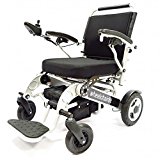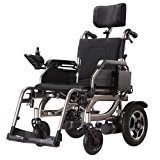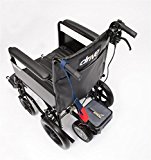There are two general types of wheelchairs – manual and electric or powered wheelchairs. Manual wheelchairs are cheaper but require that the user have adequate arm strength to operate them or depend on a caregiver to do it.
For those who want the mobility freedom of a wheelchair but don’t have the strength to use one and don’t want to depend on someone all the time, an electric wheelchair is the best choice.
Electric or powered wheelchairs use a battery-powered motor to turn the wheels. There are different types available depending on your mobility needs, level of disability and budget.
Basic powered wheelchairs are designed for use indoors and pavements and are controlled with a joystick. They are usually collapsible which allows easy storage and transportation. More advanced electric wheelchairs come with additional features like touch controls, elevating mechanism and all-terrain wheels.
When you are buying an electric wheelchair it is essential that you get one that is in match with your needs. If for instance you need to travel fairly long distances, you need a Class 3 powered wheel chair which is authorised for road use.
Consider your health and comfort requirements and if need be, talk with your doctor for advice on finding a good powered wheelchair.
Best electric wheelchair reviews – Our recommendations
Below are our top electric wheelchair recommendations. We selected them based on their performance, ease of use, safety and comfort.
1. OUR TOP PICK: Betterlife Capricorn Portable Electric Power Chair
This is an indoor/outdoor powered wheelchair.
Indoors, the easy controls and compact size make it easy to move around corners and from room to room. The wheelchair is 16.5 inches in width so it can fit through standard doorways. The wheels will not damage your carpeting or flooring.
You can adjust the height for more comfort. The position of the controller can also be changed for easier access.
For ease stepping out and into the wheelchair, it uses a swivel seat. Additionally, the armrests can be flipped up.
Outdoors, the large wheels enable the wheelchair to move over different types of terrain and easily climb over kerbs. It’s great for use around the garden or on pavements. The wheels are solid so you don’t have to worry about punctures.
The wheelchair weighs 55kgs (without battery pack). It can be taken apart into 3 pieces with the heaviest being 19.68kgs heavy. This is quite heavy. Make sure there is always someone nearby to help with assembling or disassembling the wheelchair. Read our full review of the Capricorn electric wheelchair.
What we like about it:
- Can be disassembled for easy storage.
- Comfortable padded seat with several adjustable components.
- Modern stylish design.
- Ideal for indoor and outdoor use.
2. Wheelchair88 Foldawheel PW-1000XL Power Chair
 This is perhaps the lightest and most compact power wheelchair you can buy. It weighs just 25.8kg and that’s including the battery. Even more interesting is that the whole unit can fold down to fit in the included travel bag.
This is perhaps the lightest and most compact power wheelchair you can buy. It weighs just 25.8kg and that’s including the battery. Even more interesting is that the whole unit can fold down to fit in the included travel bag.
If you are looking for an ultra-compact but heavy-duty and comfortable powered wheelchair, this is one of the best. Just be ready to spend quite a bit of money.
The wheelchair is available in right hand and left hand controller versions. Opening and folding it takes just a few seconds. When folded, it can easily fit inside the trunk of most cars.
The chair is generously wide and deep to ensure maximum comfort. It has spring suspensions that boost comfort when you are outdoors. The fairly large wheels (7inches front, 10inches rear) allow for use on different terrains and climbing over low kerbs.
Anti-tilt support wheels ensure safety especially when you are mounting over kerbs.
What we like about it:
- Includes a heavy duty travel bag.
- Extra-light and compact without affecting performance. It can comfortably support weight of up to 150kg.
- Convenient foldable design that makes handling and storage easy.
- Right and left hand versions available.
3. Betterlife Aries Electric Wheelchair
With a turning radius of 32 degrees, the Aries electric wheelchair has no trouble navigating tight spaces whether indoors or outdoors.
The deep and wide seat provides ample room for full comfort. The height is adjustable and the armrests can be flipped up for easy mounting and dismounting.
The rear wheel drive system delivers enough power to roll over low obstacles and bumpy terrain. For safety, it is fitted with reflectors, a horn and a handbrake.
When you need to travel or store it, it easily folds into a compact size measuring just 13 inches in width.
The wheel chair comes with a right-hand controller and a maximum user weight limit of 136kg. It weighs 63kgs in total with the battery included.
What we like about it:
- Ideal for indoor and outdoor use.
- Spacious and comfortable seat with adjustable height.
- Foldable design.
4. Wheelchair88 Foldawheel PW-777PL Foldable Electric Power Wheelchair
 This is a cheaper and heavier version of the Foldawheel PW-1000XL we mentioned above. It weighs 39kg which is still much lighter than most powered wheelchairs. This weight includes the battery. There is a right and left hand version available.
This is a cheaper and heavier version of the Foldawheel PW-1000XL we mentioned above. It weighs 39kg which is still much lighter than most powered wheelchairs. This weight includes the battery. There is a right and left hand version available.
The lightweight polymer Li-ion battery provides about 16km of range on a full charge. But this can vary depending on the user’s weight, terrain and driving speed.
The wheelchair is fitted with a reclinable backrest for added comfort. You can also adjust the headrest and the height for a customized fit.
For ease when getting in and out of the chair, you can raise the armrests or completely detach them. You can also remove the seat and backrest cover for washing.
When travelling, detach the armrests, footrest and headrest to ensure it fits inside the car. It weighs 30kgs when these parts are removed.
What we like about it:
- Includes a side pocket for storing personal essentials.
- Powerful polymer Li-ion battery.
- Detachable design for easy storage and transportation.
5. Drive DeVilbiss Healthcare Lightweight Dual Wheel PowerStroll with Reverse
 If you already have a manual wheelchair, you don’t have to buy a completely new electric wheelchair. An easier and less expensive option is to convert the manual wheelchair into a powered one.
If you already have a manual wheelchair, you don’t have to buy a completely new electric wheelchair. An easier and less expensive option is to convert the manual wheelchair into a powered one.
This kit does just that. It includes a battery pack, motor and two wheels. It easily fits onto the rear axle of most wheelchairs between 14 and 20 inches in width.
The installation is tool-free and you don’t need to call a professional. Your manual wheelchair should be ready to roll on its own in a few minutes.
Note that the powering module is meant to be controlled by the caregiver. The controller is fitted onto the existing handgrips where they can easily reach it.
The battery has a max range of 10 miles and top speed of 3mph. It weighs 14kg and has a maximum user weight limit of 115kg.
What we like about it:
- Comes with a reverse function.
- Easy and quick installation.
- Compatible with most manual wheelchairs including narrow track models.
Considerations when buying a powered wheelchair
1. Your height and weight
An ill-fitting wheelchair is not just uncomfortable it can also worsen the user’s health. Poor support, constricted muscles and bad posture can all cause serious health problems.
That’s why it is recommended that you work with your doctor or a local wheelchair service to find the best wheelchair for you. If you decide to do it on your own, make sure you know your exact height and weight. Then carefully check the dimensions of the wheelchair you are about to buy.
The seat should be deep enough that your knees are not dangling far out. It should also be wide enough to accommodate your full frame and leave some wiggle space.
Make sure that the wheelchair has adjustable height. This allows you to choose the perfect position where your feet are resting comfortably on the footrests.
Check the maximum weight limit of the wheelchair. Most models can support at least 100kgs and some have a higher limit of up to 140kgs.
2. Your comfort needs
Consider any specific comfort needs you have either because of age, illness or disability. Maybe you have back pain which requires good backrest support or a painful pressure point in your hips that requires a wider seat.
Overall, a wheelchair should be very comfortable. You are probably going to spend a lot of time in it. Even small discomforts can get magnified. Make sure the padding is thick enough and that the controller is placed at the right position or even better, it’s adjustable.
The cover on the seat and backrest should be breathable to keep your skin from getting hot and sweaty. If the cover is removable and washable, the better.
3. Level of mobility
Your level of mobility will greatly determine what kind of powered wheelchair is best for your needs. If for instance you have no mobility in your arms, you’ll not be able to use a hand controller. You’ll need a wheelchair with specialised chin, voice or sip-and-puff controls.
If you can’t stand up on your own, consider getting a wheelchair with stand-up assist.
For easy transfer to and from the wheelchair, check whether the armrests can be removed or at least flipped up out of the way.
4. Wheelchair class
The department for transport considers mobility scooters and powered wheelchairs as ‘invalid carriages’. They can belong to one of two classes: Class 2 or Class 3.
Class 2 powered wheelchairs can only be used on the pavement (but can be used on roads where there is no pavement or when crossing the road). They must not exceed a speed of 4mph. Class 2 electric wheelchairs don’t need to be registered.
Class 3 powered wheelchairs can be used on the road. They must not exceed a speed of 8mph on the road and 4mph when off the road. They must be registered and follow all road rules that apply to motor vehicles.
If you need a wheelchair for use at home, around your garden and maybe for short strolls, get a class 2 wheelchair. If you plan to travel long distances by road, a class 3 wheelchair is best.
Note that class 3 wheelchairs are usually bigger and heavier. This is because they need bigger batteries and motors to handle higher speeds and tougher terrain. They might be more difficult to handle during storage, maintenance or transportation.
Powered wheelchairs FAQs
1. How do you charge an electric wheelchair?
Electric wheelchairs can be charged using a standard home outlet. Just plug it in. Most wheelchairs take between 4-10 hours to completely recharge.
Some wheelchairs allow you to remove the battery pack and charge it separately from the rest of the wheelchair. This is convenient when you cannot carry the full wheelchair inside or upstairs.
2. How much do powered wheelchairs weigh?
Electric wheelchairs are heavy. A big chunk of the weight comes from the battery and motor. The average weight range for powered wheelchairs is 40-60kgs. But you can also find ultra-light wheelchairs weighing less than that. A good example is the Wheelchair88 Foldawheel PW-1000XL which weighs just a little over 25kgs.
3. Can rain/water damage an electric wheelchair?
Most likely not but take precautions. The motors can still function even when submerged under shallow water and the batteries are tightly sealed to prevent water penetration. The most vulnerable component is actually the controller.
Some wheelchairs come with rain covers that cover part of your body and wheelchair.
When you are washing the wheelchair or if you shower with it, be careful to direct the water away from sensitive components like the motor and controller.
Most importantly, check the user manual to see specific manufacturer recommendations.
4. Can kids use powered wheelchairs?
Yes, children can use powered wheelchairs. It’s recommended that they get training to manoeuvre the wheelchair especially when among other people. Check whether there is a local wheelchair service or organization in your area that offers this kind of training to kids.
By law, children under 14 years are restricted to class 2 powered wheelchairs.
5. How to make a manual wheelchair electric?
Using an electric conversion kit. It includes a battery pack and wheels and easily connects to a normal wheel chair, turning it into an electric wheelchair.
The conversion kit also includes a control module for speed control, turning and reversing.
6. How does an electric wheelchair work?
An electric wheelchair has four main components that allow it to move: batteries, a motor, a drive system and a controller.
The battery powers the motor, which in turn powers the drive system that moves the wheels.
A controller lets the user navigate the wheelchair and adjust its speed.
Most electric wheelchairs use a manual braking system for slowing down and locking the wheelchair.
7. Where can I hire an electric wheelchair?
- NHS: The NHS can offer you a powered wheelchair on loan, though you’ll need to complete a mobility assessment. You’ll also have to wait until a wheelchair becomes available.
- Motability Scheme: If you receive a higher rate mobility allowance, you can use it to lease a new electric wheelchair for three years via Motability. Your allowance – all of it or part of it, depending on the cost of wheelchair – goes towards paying for the lease.
- Private companies: Some companies offer short term and long term electric wheelchair hires.
- Charities: Some charities that cater to disabled and elderly persons offer low-cost or free power wheelchair hires.
